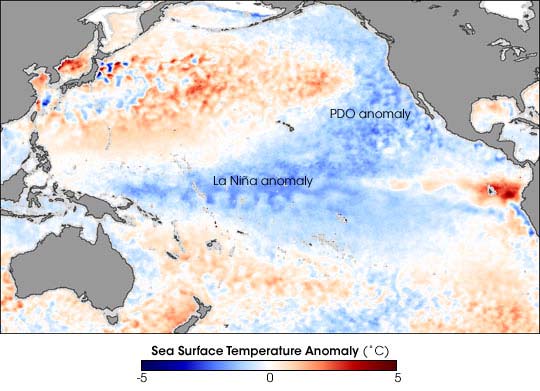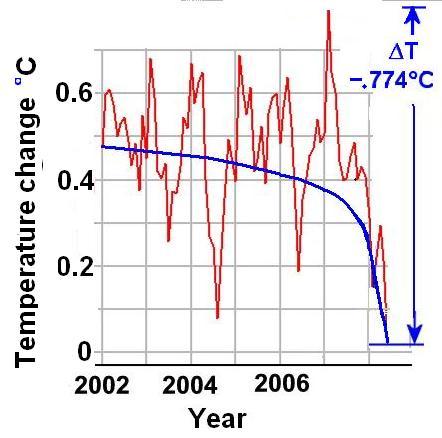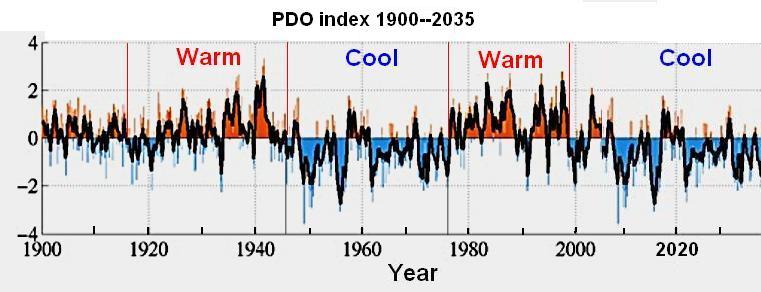
Shifting of the Pacific Decadal Oscillation from its warm
mode to cool mode assures global cooling for the next three
decades.
Don J. Easterbrook, Dept. of Geology, Western Washington University, Bellingham, WA
Addressing the Washington Policymakers in Seattle, WA, Dr. Don Easterbrook said that shifting of
the Pacific Decadal Oscillation (PDO) from its warm mode to its cool mode virtually assures global
cooling for the next 25-30 years and means that the global warming of the past 30 years is over. The
announcement by NASA that the (PDO) had shifted from its warm mode to its cool mode (Fig. 1) is right
on schedule as predicted by past climate and PDO changes (Easterbrook, 2001, 2006, 2007) and is not an
oddity superimposed upon and masking the predicted severe warming by the IPCC. This has significant
implications for the future and indicates that the IPCC climate models were wrong in their prediction of
global temperatures soaring 1°F per decade for the rest of the century.
Figure 1. Cooling of the Pacific Ocean and setting up of the cool-mode PDO. Sea surface temperature
anomaly in the Pacific Ocean from April 1421, 2008. The anomaly compares the recent temperatures
measured by the Advanced Microwave Scanning Radiometer for EOS (AMSR-E) on NASA's Aqua
satellite with an average of data collected by the NOAA Pathfinder satellites from 19851997. Places
where the Pacific was cooler than normal are blue, places where temperatures were average are white, and
places where the ocean was warmer than normal are red. The cool water anomaly in the center of the
image shows the lingering effect of the year-old La Niņa. However, the much broader area of cooler-than-
average water off the coast of North America from Alaska (top center) to the equator is a classic feature
of the cool phase of the Pacific Decadal Oscillation (PDO). The cool waters wrap in a horseshoe shape
around a core of warmer-than-average water. (In the warm phase, the pattern is reversed). Unlike El Niņo
and La Niņa, which may occur every 3 to 7 years and last from 6 to 18 months, the PDO can remain



in the same phase for 20 to 30 years. (NASA image by Jesse Allen, AMSR-E data processed and
provided by Chelle Gentemann and Frank Wentz, Remote Sensing Systems. Caption by Rebecca Lindsey,
adapted from a press release from NASA JPL).
Instead of a rise of 1°F during the first decade of this century as predicted by IPCC climate models (Fig
2), global temperatures cooled slightly for the past nine years and cooled more than 1°F this year (Fig 3).
Global cooling over the past decade appears to be due to a global cooling trend set up by the PDO cool
mode and a similar shift in the Atlantic. The IPCC's prediction of a 1° F warming by 2011, will require
warming of about 1° F in the next three years and unless that happens, the IPCC models will be proven
invalid.
Figure 2. IPCC predicted warming.
Figure 3. Measured cooling.
As shown by the historic pattern of PDOs over the past century (Fig. 4) and by corresponding global
warming and cooling, the pattern is part of ongoing warm/cool cycles that last 25-30 years. Each time the
PDO mode has shifted from warm to cool or cool to warm, the global climate has changed accordingly.
In 1977, the PDO shifted from cool mode to warm mode (Fig. 4) and set off the global warming from
1977 to 1998, often referred to as the "Great Climate Shift." The recent shift from PDO warm mode to
cool mode is similar to the shift that occurred in the mid-1940's and resulted in 30 years of global cooling
(Fig. 4). The global warming from ~1915 to ~1945 was also brought on by a mode shift in the PDO (Fig.
4). Every indication points continuation of the PDO patterns of the past century and global cooling for
the next 30 years (Fig. 4). Thus, the global warming the Earth has experienced since 1977 appears to be
over!
Figure 4. PDO indices, 1900-2008 with predictions to 2040.



